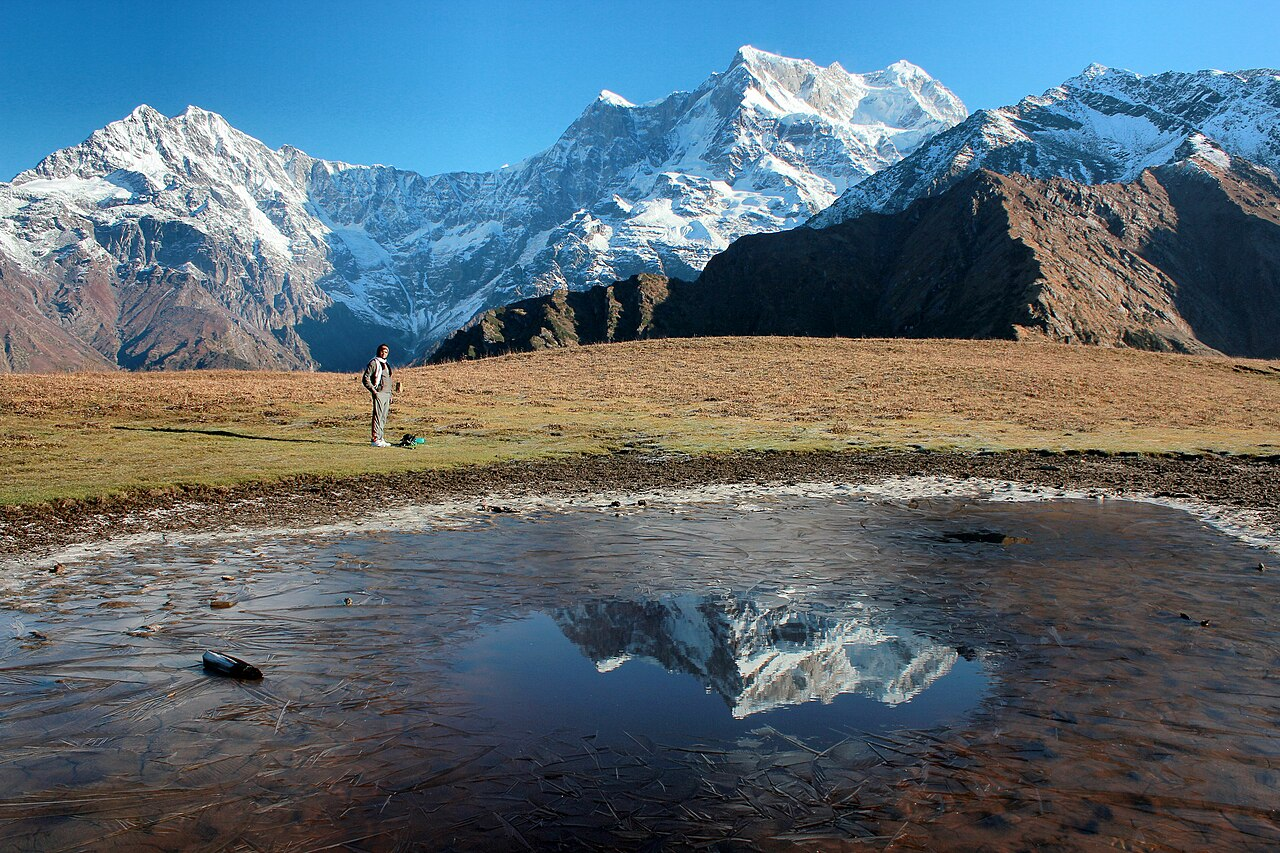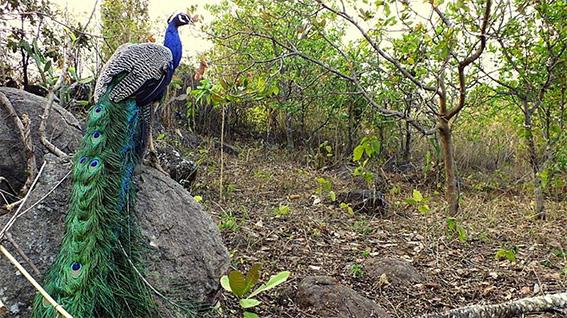Uttarakhand Switch to Hindi
Rescue of Climbers at Chaukhamba III
Why in News?
Recently, two foreign climbers, Michelle Theresa Dvorak (USA) and Fay Jane Manners (UK), were rescued from 6,015 meters height near the Chaukhamba III peak in Uttarakhand's Chamoli district.
Key Points
- Chaukhamba:
- It is a mountain massif in the Gangotri Group of the Garhwal Himalayas, Uttarakhand, India, located west of Badrinath. It features four summits along a northeast-southwest ridge:
- Chaukhamba I: 7,138 m (23,419 ft)
- Chaukhamba II: 7,070 m (23,196 ft)
- Chaukhamba III: 6,995 m (22,949 ft)
- Chaukhamba IV: 6,854 m (22,487 ft)
- It is a mountain massif in the Gangotri Group of the Garhwal Himalayas, Uttarakhand, India, located west of Badrinath. It features four summits along a northeast-southwest ridge:
- The mountain lies at the head of the Gangotri Glacier, forming the eastern anchor of the group, with the highest peak, Chaukhamba I, being the tallest in the Gangotri range.
Chamoli District
- Chamoli is a district in Uttarakhand, India, with its administrative headquarters located in Gopeshwar.
- It is bounded by Tibet in the north and several Uttarakhand districts, including Pithoragarh, Bageshwar, Almora, Pauri Garhwal, Rudraprayag, and Uttarkashi.
- Chamoli is renowned for several religious and tourist destinations, such as Badrinath, Hemkund Sahib, and the Valley of Flowers.
- Historically, Chamoli holds significance as the birthplace of the Chipko movement, a pioneering environmental campaign.
Gangotri Glacier
- Gangotri Glacier is situated in the Uttarkashi District of Uttarakhand.
- The Gangotri glacier originates at the northern slope of Chaukhamba range of peaks in Garhwal Himalayas. It is about 30 km long and 0.5 to 2.5 km wide.
- Gangotri is not a single valley glacier, but a combination of several other glaciers. This glacier comprises three main tributaries, namely Raktavaran (15.90 km), Chaturangi (22.45 km) and Kirti (11.05 km) and more than 18 other tributary glaciers.
- Bhagirathi, the source stream of the Ganga, originates from the Gaumukh Glacier located in the Gangotri region of Uttarkashi, Uttarakhand. The Ganga is the combined water of the five major headstreams: Bhagirathi, Alaknanda, Mandakini, Dhauliganga, and Pindar, all of which rise from the mountainous region of northern Uttarakhand.
Uttarakhand Switch to Hindi
"Peacock Spotted at 6,500 Feet in Uttarakhand"
Why in News?
Recently, peacocks were sighted at an unusual altitude of 6,500 feet in Uttarakhand's Bageshwar district, indicating ecological changes due to increased human activity.
Key Points
- The peacock, normally seen at 1,600 feet, was spotted in the Kafligair (April) and Kathayatbara (October) forest ranges.
- Experts believe warmer conditions at higher altitudes, influenced by human expansion, may explain the bird's altitudinal migration.
- Experts from Wildlife Institute of India (WII) suggest it may be a seasonal shift, as cooler winter temperatures could prompt the bird to retreat.
Peacock
- The collective name for peacocks is peafowl. The male of the variety is called a peacock and the female peafowl is called a peahen.
- The Indian peacock is also the National Bird of India.
- Peafowl (Pavo cristatus) belongs to the Phasianidae family. They are among the largest of all birds that fly.
- Phasianidae is the pheasant family, a bird family that includes among its members the jungle fowl (from which the domestic chicken is descended), partridge, peacock, pheasant, and quail.
- The two most-recognizable species of peafowl are:
- The blue Peacock/ Indian Peacock found in India and Sri Lanka.
- The green or Javanese peacock (P. muticus) found in Myanmar (Burma) to Java.
- Habitat:
- The Indian peafowl is a native of India and some parts of Pakistan and Sri Lanka.
- The species are currently habituated more in central Kerala, followed by southeast and northwest parts of the state.
- At least 19% of the states’ area is suitable habitat for this species and this may increase by 40-50% by 2050.
- They are well adapted to living in forest edges and cultivated areas.
Uttarakhand Switch to Hindi
Green Nod for Hydro Project in Uttarakhand
Why in News?
Recently, a fresh approval for the Phata Byung Hydropower Project in Uttarakhand hinges on environmental, forest, and wildlife clearances.
Key Points
- Project:
- It is a 76 MW run-of-the-river project on the Mandakini River in Rudraprayag.
- The project was extensively damaged during the 2013 floods caused by a cloudburst.
- The Environment, Forest and Climate Change Ministry stressed forest and National Board for Wildlife (NBWL) clearances.
- Concerns:
- Glacial lake outburst floods are a major concern.
- There are 24 lakes near the site and 6 are considered critical.
The Mandakini River
- It is a tributary of the Alaknanda River in Uttarakhand.
- The river runs for approximately 81 kilometers between the Rudraprayag and Sonprayag areas and emerges from the Chorabari Glacier.
- The Mandakini merges with river Songanga at Sonprayag and flows past the Madhyamaheshwar temple at Ukhimath.
- At the end of its course it drains into the Alaknanda, which flows into the Ganges.
Glacial Lake Outburst Flood (GLOF)
- About:
- A glacial lake outburst flood (GLOF) is a type of catastrophic flood that occurs when the dam containing a glacial lake fails, releasing a large volume of water.
- This type of flood is typically caused by rapid melting of glaciers or the buildup of water in the lake due to heavy precipitation or the inflow of meltwater.
- In February 2021, Chamoli district in Uttarakhand witnessed flash floods which are suspected to have been caused by GLOFs.
- Causes:
- These floods can be triggered by a number of factors, including changes in the volume of the glacier, changes in the water level of the lake, and earthquakes.
- According to NDMA (National Disaster Management Authority), glacial retreat due to climate change occurring in most parts of the Hindu Kush Himalayas has given rise to the formation of numerous new glacial lakes, which are the major cause of GLOFs


.png)




.jpg)























.png)


.jpg)

 PCS Parikshan
PCS Parikshan



